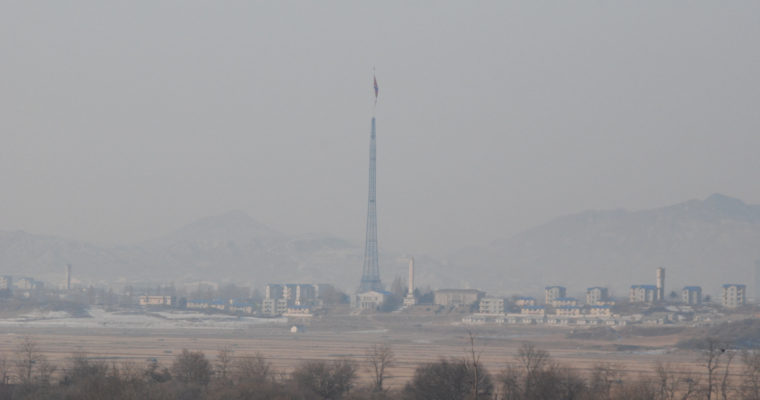Military subsistence at the DMZ was supported by the Panmunjom Village. Villagers did not pay any taxes to the Korean government as it did not come under its administration. They grew food in their fields, and one important crop was ginseng. The area being off-bounds to most human beings made it ideal for this cash crop to grow in isolation. It took six years to grow ginseng and only under shades. Thus when we passed by the fields we could see the black materials covering the soil. We were not allowed to take pictures of the village.
There was, of course, a relationship between the troops and the villagers. They went in to teach village children English. The women could move about as they wished, but the men could not due to the military presence. There was not one woman there besides my fellow tourists.
We passed by a golf course and the military guide said that it was the third most dangerous golf course in the world. Someone asked, “what would be the first and second most dangerous?” “First in Afghanistan,” he said, “second in Iraq.”
We then visited the shacks where the actual border was, the heart of tensions. We entered through the hall, then to the conference room, the site where the peace negotiations once took place. There were polymers in the middle of the conference table denoting the actual border of the two Koreas. We saw two South Korean soldiers guarding the conference room. They wore their military helmets with Koreans words on them. One stood where the UN Flag was, right at the border. He would beat anyone who attempted to desecrate the UN Flag.


This was as close as it gets for a foreigner to “go to North Korea” without a VISA. As we could walk freely inside the conference room, we made symbolic entry into the North. The guide was just taking note of how the North Korean soldiers would peep into the conference room when the tourists visit, and there they were, looking on at us from the outside, intending to intimidate us. It did send chills down my spine.
“You are not to communicate with them, directly or indirectly,” Officer Pearson said. “Can we take pictures of them through the window?” “No, you cannot,” he said, “in fact, do not even look back at them.
We left the conference room and went back far behind from the border. At the steps of the building we looked far onto the military administration building in the North. Three large Korean words were on display there, but I forgot what they meant. A soldier stood on the steps very far away, and the view was of such communist menace, conveyed on a typical communist-styled building, that spoke loud intimidation past the distance.

I looked on, almost with tears in my eyes. I wondered how it was that a country once one could be split along the rift of ideology. Centuries of common heritage did not hold it together. Could it have been Karl Marx’s mistake, or the motives of the powers of the world, that drove the wheel of history in the century past, causing one people in a relatively small nation in Asia to go their separate ways, each choosing ideas that were incompatible but neither represented the best of humanity?
Soldiers from the North and the South guarded the border at arm’s length to each other, but really living two worlds apart. Would they not wonder what life was like on the other side? Would it be better living in a world where truth was not allowed, or living in a world where truth can only come by with a lifetime’s effort to unmask the web of materialism that numbs the best of one’s soul?
We could freely take photographs from afar at the South Korean steps. By now, quite a number of the North Korean soldiers have come out. They pretended to take photos of each other at first, but a while later they stopped pretending and just took images of us. I was sure my loud yellow down jacket would go down their records as the best propaganda material for the North Korean regime. Two more South Korean soldiers came out and guarded between us and the North Korean soldiers.
The North Korean soldiers wore the classic communist military attire, reminding me of the older Soviet uniforms and Chinese PLA uniforms in a bygone era. Maybe even in their dress code the North Koreans guarded the orthodoxy of communism,[1] or perhaps they did not have the means to upgrade to the helmets that the South Korean soldiers were wearing. The true distance between the two Koreas was evident in plain sight.
We left the building and saw the South Korean Peace Museum, which ironically housed the two axes that killed the two UN commanders in the Axe Incident. The building was already ahead of its time, its significance to be celebrated when one day the two Koreas are reunited. It will act as a vivid reminder to future generations that peace was really a long path of past rife eventually reconciled, and it never comes by easily.
We visited the Dora lookout, but could not take photographs of the building or beyond the yellow line. “There is internet there,” the guide said. I thought what he really meant was satellite surveillance. There, once again, North Korea’s landscape exhibited itself in a haze, standing still in an unreachable distance.
[1] Paul French has a very good section on North Korea’s spin on communism. See Paul French, North Korea, State of Paranoia, chapter 2.
This is part of a series on the Demilitarized Zone at the 38th Parallel separating North and South Koreas. Please visit the other entries in this series below:
South Korea – The DMZ and the Bollinger Hall.
South Korea – The DMZ and the Bridge of No return.
South Korea – The DMZ and the Infiltration Tunnels.












